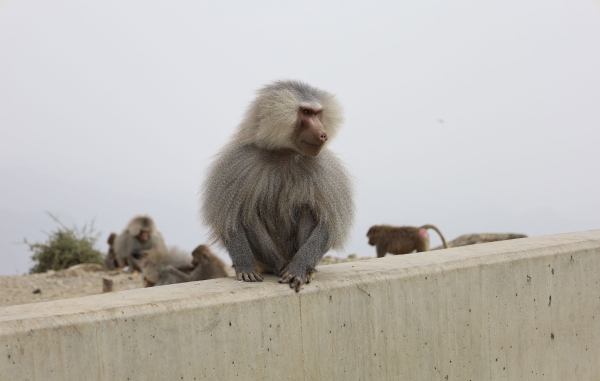
The Baboon is a monkey belonging to the Cercopithecidae family, which is native to Africa and Asia. In the Arabian Peninsula, only one species is found, inhabiting the western and southwestern regions. It is believed that it arrived in the Arabian Peninsula before the formation of the Red Sea basin. This monkey is found in the western and southwestern parts of the Kingdom of Saudi Arabia.
The Cercopithecidae family includes monkeys with long tails, others with short or reduced tails, round faces, hands adapted for walking and climbing, and colored rump patches. The baboon is known by various names in Arabic, including "al-Rubah, al-Houdal, al-Qurdoh, al-Habbaar, and al-Rubh." It also has several nicknames, such as "Abu Khalid, Abu Roubah, and Abu Fishah."
Baboon lifestyle
Baboons live in large groups, with troop sizes ranging between fifty and one hundred monkeys, and sometimes reaching several hundred in food-rich environments such as forested areas. In poorer environments or areas lacking permanent food resources, troop sizes decrease. Typically, a troop consists of one dominant male, five females, and their offspring. Living in groups provides baboons protection from predators, mating opportunities, and a way to learn the skills required to find food.
The male baboon is larger than the female and has a silvery mane covering the back of its head, neck, and shoulders, giving it a majestic appearance. It also has large canines used for defense and attack. Its face is hairless, with small, closely set eyes. Some Bedouins refer to the male baboon as “al-Kabsh." Baboons have long tails ending in a tuft of hair, which they hold up when walking.
A nursing female holds an important position in the troop, and the young are favored and cared for by all troop members, who play with them and ensure their safety. Adult males often face difficulty with the troop’s dominant male and are usually forced to leave the group.
Baboon reproduction
Baboons breed year-round. Females have a monthly estrous cycle, being in heat and receptive for about one week each month, except during pregnancy and lactation. Gestation lasts about six months, after which the female gives birth to one or two offspring. The newborn clings to its mother’s fur right after birth, allowing it to keep moving with the troop effortlessly. Newborns have pink skin, black fur, and large ears. Females reach maturity at around four years of age, while males mature in their fifth year. Baboons can live for about forty years.
Baboon food
Baboons eat both plants and meat. They eat plant leaves and fruits, such as berries, acacia leaves and gum, Buckthorn (Rhamnus), wildflowers, and the pods of Acacia tortilis and Vachellia seyal. They also eat reptiles, beetles, ants, and butterflies. At nightfall, baboons retreat to a sleeping site chosen carefully to protect against predators like leopards, wolves, and hyenas, often steep, rocky cliffs. Several troops may gather at the same place to spend the night, then disperse into the valleys at sunrise.
Distribution of baboons in Saudi Arabia
Baboons are widely distributed in the west and southwest provinces of Saudi Arabia, including Makkah al-Mukarramah, al-Madinah al-Munawwarah, al-Bahah, Aseer, Jazan, and Najran. In 2024, the National Center for Wildlife (NCW) estimated that there are more than five hundred focal points in these provinces, harboring over 41,000 habituated baboons, based on modern technological monitoring.
Program to address the increase in baboon numbers
Starting in 2022, the NCW, in collaboration with various government entities, launched an eight-year program to address the significant increase in baboon populations, an upswing that began in the 1980s. This increase has led to environmental, social, economic, and health issues, such as preying on other creatures and upsetting ecological balance, stripping trees, transmitting certain diseases, attacking farms and damaging property, and entering residential areas. There are also concerns about the behavior of roaming troops that frighten children and residents, create hazards on highways and in public parks, and distort the image of tourist destinations where they proliferate.
Reasons behind the increase in baboon populations
According to the NCW, the presence of baboons in balanced numbers is beneficial for the environment, but the goal is to achieve an ecological and natural balance. Studies have confirmed that one of the reasons for the increase in stray baboon populations in certain regions is the direct feeding by passersby and tourists or indirect feeding through access to garbage bins and dumps. Feeding these baboons leads to scattered food waste and the accumulation of trash. Additional factors include the decline or absence of natural predators, a shortage of natural food in baboon habitats due to drought, a shift in baboon behavior from wild to habituated, and changes in reproductive behavior within troops.
The program to address the increase in baboon populations is part of programs aimed at restoring, flourishing, and sustaining ecosystems, protecting biodiversity, achieving environmental balance, and raising public awareness about environmental issues.
Stages of the baboon population management program
The program to manage the increase in baboon numbers is based on finding a long-term solution based on scientific principles involving comprehensive and sustainable solutions. The first stage of the program, implemented with the participation of national and international universities and experts, included studying, evaluating, and surveying baboon populations and the focal points, preparing maps of vegetation, water resources, and thermal coverage in affected areas, testing samples of baboons for zoonotic diseases, establishing baseline data, reviewing global best practices, evaluating natural habitats, and identifying diseases transmissible between baboons and humans.
This stage was followed by the stage of addressing baboon focal points in affected areas, such as major cities, villages, agricultural areas, and focal points along main roads, in addition to monitoring treated areas and responding to reports. It began in May 2023 and will continue until December 2026. This stage addressed more than four hundred focal points containing approximately thirty thousand baboons. Addressing efforts started in the Holy Sites areas, ensuring they were completely cleared of baboons and processing the issues they caused in these areas. Hundreds of informational signs and dozens of surveillance cameras were installed, nationwide awareness campaigns were conducted, and an electronic app for baboons was developed. In addition, monitoring efforts continue, alongside addressing root causes, restoring ecological balance, organizing regular meetings with residents and farmers in affected areas, and evaluating the status of garbage bins and landfills in coordination with municipal authorities. This stage also included measuring the social and economic impact of the integrated baboon control project by collecting surveys from citizens in affected areas and analyzing them using advanced models. The goal was to assess the level of awareness regarding the dangers of feeding these animals and to evaluate how the findings could influence awareness programs. A regulation was enacted to prohibit the feeding of baboons, with a financial penalty of SAR500 imposed on violators.
The NCW, in collaboration with government entities, launched a media campaign under the hashtag "More Than One Problem" to raise awareness and mobilize efforts regarding the issues caused by baboons. It urged people not to feed baboons, to dispose of waste in designated areas, to avoid keeping baboons as pets, and to prevent their adaptation to living outside their natural habitat.
The third stage extends until 2030, aiming to ensure the sustainability of the solutions by establishing a Sustainability Unit to maintain ongoing awareness programs, continuous monitoring, and coordination with regional governorates, municipal authorities, and relevant entities, as well as develop new mechanisms to sustain the solutions.
Related quizzes
Related articles


